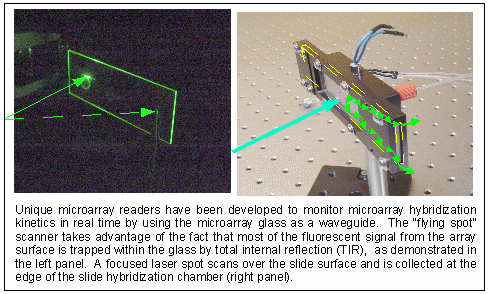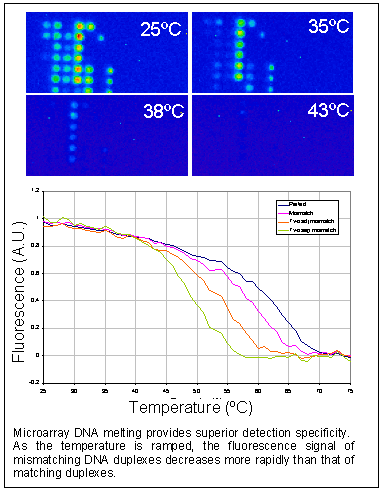 |
 |
Waveguide Microarray Scanner
Waveguide Array Readers
Many microarray applications, such as high-throughput
SNP
detection, require a very high level of specificity.
Perfectly matching DNA sequences must be distinguishable from
mismatching sequences. The ISB has constructed two microarray
readers that improve on the specificity of conventional array
hybridization by measuring every probe spot at its optimal stringency
during temperature ramping. The designs were primarily driven by
the requirement that the array be imaged repeatedly while exposed to a
wash solution. Most commercially available scanners move the
microarray through a focused laser beam in a confocal-microscope
arrangement. While this provides good signal sensitivity, it is
rather slow and poorly-suited to use with an array sealed within a
hybridization chamber. Both ISB designs can be described as waveguide
readers. The "Flying Spot" design uses laser scanning excitation
with waveguide collection, while the "Evanescent wave" design uses
waveguide excitation and CCD camera imaging.

Non-equilibrium dissociation profiles are used to better discriminate
matching and mismatching DNA. After hybridization and washing,
arrays may be monitored as temperature is increased. The
resulting dissociation (melting) curves for all matching and
mismatching duplexes are used to define dissociation temperatures (Td).
Td , the point at which 50% of the starting duplexes are
still intact, is correlated to melting temperature ( Tm).
By comparing Tm and Td, true hybridization can be
distinguished from cross hybridization. This specificity
dramatically improves the success of allele-specific hybridization as a
genotyping platform

|
 |
 |
